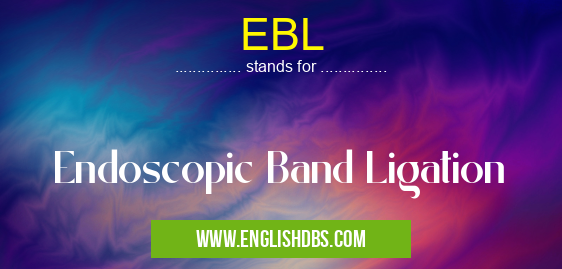What does EBL mean in MEDICAL
EBL stands for Endoscopic Band Ligation. It is a minimally invasive procedure used to treat esophageal varices, which are enlarged veins in the esophagus. These varices can rupture and cause life-threatening bleeding.

EBL meaning in Medical in Medical
EBL mostly used in an acronym Medical in Category Medical that means Endoscopic Band Ligation
Shorthand: EBL,
Full Form: Endoscopic Band Ligation
For more information of "Endoscopic Band Ligation", see the section below.
What is EBL?
EBL involves placing small rubber bands around the base of the varices using an endoscope, a thin, flexible tube with a camera and light on the end. The bands cut off the blood supply to the varices, causing them to shrink and eventually disappear.
Advantages of EBL
- Less invasive than surgery
- Can be performed on an outpatient basis
- Relatively low risk of complications
- Effective in preventing bleeding from esophageal varices
Procedure
EBL is typically performed under sedation. The endoscope is inserted through the mouth and into the esophagus. The varices are located and the bands are placed around their base. The procedure usually takes 15-30 minutes.
Recovery
After EBL, patients may experience some discomfort in the throat and esophagus. They may also be instructed to avoid strenuous activity for a few days. Most patients can return to their normal activities within a week.
Essential Questions and Answers on Endoscopic Band Ligation in "MEDICAL»MEDICAL"
What is Endoscopic Band Ligation (EBL)?
Endoscopic Band Ligation (EBL) is a minimally invasive procedure used to treat bleeding esophageal varices, which are swollen veins in the esophagus. It involves placing small rubber bands around the varices to stop them from bleeding.
What are the indications for EBL?
EBL is primarily indicated for the treatment of bleeding esophageal varices caused by cirrhosis of the liver. It is also used as a preventive measure to prevent bleeding in patients with high-risk varices.
How is EBL performed?
EBL is performed using an endoscope, a thin, flexible tube with a camera at the tip. The endoscope is inserted through the mouth and into the esophagus. The varices are identified, and small rubber bands are placed around them using a ligator.
Is EBL effective?
EBL is an effective treatment for bleeding esophageal varices. Studies have shown that it can successfully stop bleeding in over 90% of cases and reduce the risk of rebleeding.
What are the potential complications of EBL?
EBL is generally safe, but potential complications include chest pain, esophageal ulceration, and bleeding. These complications are usually mild and transient.
Is EBL a permanent solution?
EBL is not a permanent solution for esophageal varices. The varices may recur over time, especially if the underlying liver disease is not treated. Therefore, regular follow-up endoscopies are necessary to monitor for recurrence.
Final Words: EBL is an effective and relatively low-risk procedure for treating esophageal varices. It can help prevent life-threatening bleeding and improve the quality of life for patients with this condition.
EBL also stands for: |
|
| All stands for EBL |
